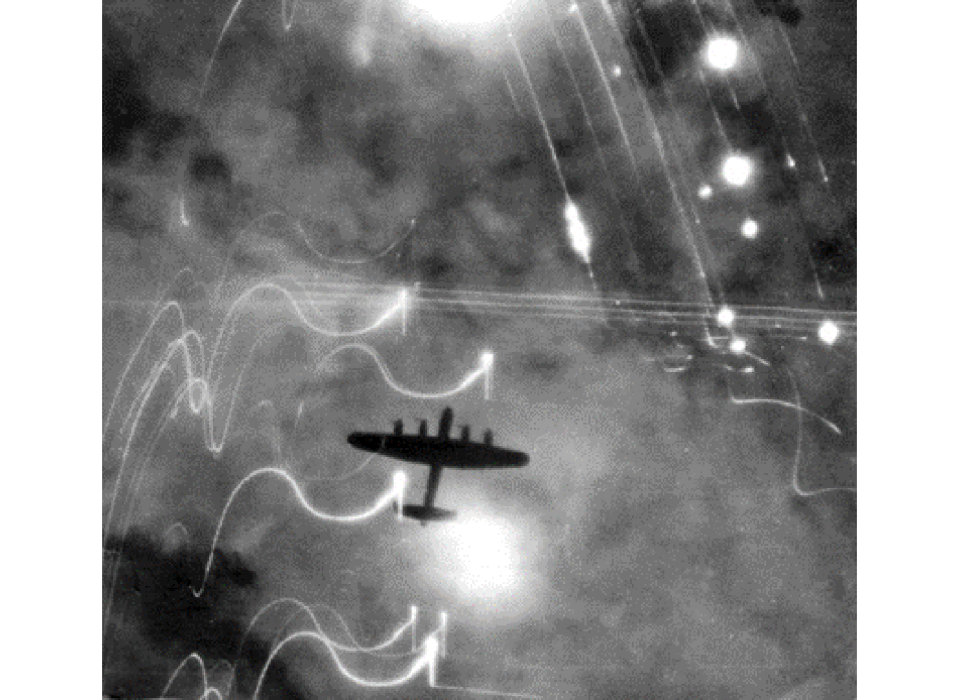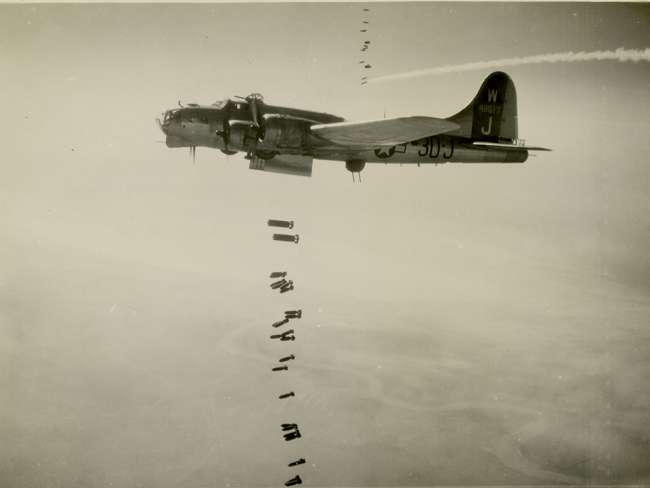A Royal Air Force Lancaster bomber over Hamburg during Operation Gomorrah. Note the flares surrounding the bomber’s silhouette.
Strategic bombing was developed during the interwar years to avoid the bloody, stagnant trench warfare of World War I. Intended to destroy an enemy nation’s ability to man, train, and equip a war effort, strategic bombing took aim at factories, infrastructure, and other economic engines. Its proponents believed that such raids might have more than just a material effect of destruction: Many advocates believed that an aerial campaign against population centers might also affect the enemy’s home front morale. One of the countries embracing this idea was Great Britain, and this shaped the development of the Royal Air Force’s (RAF) Bomber Command. As a result of Nazi Germany’s aggression, England initiated such a strategic bombing campaign over the Third Reich.
Initially, Bomber Command avoided targeting civilian populations, but such considerations were soon discarded after the German raid on Rotterdam and especially after the Battle of Britain. Bombing cities in the Third Reich as early as May 1940, the RAF hit shipyards and factories located along the Rhine and Ruhr river valleys. However, in these raids RAF crews understood early on that precision strikes from 15,000 to 20,000 feet were impossible. While never the official policy, British bombers targeted entire cities using an area bombardment methodology. Initial claims of casualties from RAF raids were often exaggerated by German propaganda, but soon enough those numbers would match the grim reality.
In 1943, Hamburg, Germany, housed many manufacturing plants and transportation centers, and was home to the Blohm and Voss shipyards, which built the U-boats threatening the very existence of Great Britain. During that year’s unusually dry and hot summer, RAF Bomber Command’s Air Marshal Sir Arthur “Bomber” Harris determined the northern German city a worthy target. Planning to strike this center of industry, Harris ordered a 10-day-long campaign targeting the city, code-naming it Operation Gomorrah, a reference to the biblical rain of ruin and fire coming from above. Originally planned for July 22, the raid was delayed for two days due to cloud coverage; by the 24th, the skies had cleared. That evening, starting at approximately 10:00 p.m., 791 British bombers took off under cover of darkness. The air fleet was composed of British Lancaster, Stirling, Wellington, and Halifax bombers flying in six waves. Each wave had between 100 to 120 aircraft hoping to concentrate as much destruction as possible.
Although the Germans had created a robust integrated air defense, on this night, Luftwaffe radars were rendered useless as the RAF released small strips of tin foil. Referred to as “window,” these strips of foil confused the radar returns, electronically blinding interception controllers. Preceding the bomber waves were pathfinder aircraft that marked the routes to the city and the aim points. Once over the designated targets, the pathfinders dropped red, yellow, and green to identify the release/aim points for the incoming waves. They burned so brightly and colorfully that the Germans below called them Tannenbaum (Christmas trees). They looked to many like a wonderful pyrotechnics display. One German on the ground remembered: "I stood there looking out at … the wonderful sky … prettier, much prettier than a fireworks display.” However, the beauty was short lived.
Between 1:00 a.m. and 2:00 a.m., 2,300 tons of bombs were dropped on the city, setting a new world record. Included in the aerial salvo were 8,000-pound “block busters” and 4,000-pound “cookies,” along with over 350,000 individual incendiary bombs. It was these incendiary bombs that caused much of the havoc. Eyewitnesses described the next few hours as filled with a continuing stream of explosions. Time stood still as people crammed into shelters with the mass of humanity shaking along with the structures’ concrete walls; with no lights, water, or food, the people who made it to safety could only wait. Most of the destruction was not from the explosions, but the ensuing fires. This was intended as incendiaries started the fires, but cleverly placed high explosive bombs along with delayed-action fuses prevented fire brigades from reacting to the resulting blaze. As the RAF bombers cleared the area and returned home, it was discovered that this first raid cost them a mere 12 planes.
As the night passed and survivors emerged from their shelters, they saw only thick black smoke over the city as fires burned, with many lasting several days. Even by late morning, the sun was barely visible as its rays struggled to penetrate the smoke. The physical damage was immense, leaving no part of central Hamburg unscathed. But beyond the physical damage, the mental and emotional toll was staggering, with many shocked and unsure what to make of the night’s events. This first raid left many inhabitants dazed by the violence and destruction wrought on their city.
However, for the residents of Hamburg, this was only the beginning. More raids were to come. With the afternoon sun finally breaking through, 123 American B-17 “Flying Fortress” bombers arrived over the city. The American approach to strategic bombing was much different from the British. The US Army Air Forces (USAAF) professed a doctrine of daylight precision that looked to avoid area bombardment and strike only designated military and strategic targets. Hoping to avoid the moral quagmire of mass atrocities, the USAAF professed great faith in its Norden Mk XV bombsight. However, flying without fighter escort and clearly visible to German radar and day fighters, the American formations were quite vulnerable. Still, the six bomb groups continued to their targets: the city’s shipyards and the Klockner aircraft engine factory.
Flying in clear air with unlimited visibility, the American formation approached the mouth of the Elbe River as German fighters rose to meet the bombers. Flying through the Luftwaffe defenses, the bombers made it to the city without a loss, although that was not the only obstacle. German Fliegerabwehrkanonen (antiaircraft guns, or Flak) opened fire upon the formations taking its toll on the planes. Thwarting the precision-targeting effort, the smoke from the previous night’s conflagration made it difficult to locate designated targets. A break in the smoke allowed bombardiers to sight a different shipyard in the area, but the engine factory remained obscured. The groups assigned to the factory target held their bombs until later, hitting a rail yard at Heide as a target of opportunity. But, now both formations had to head home.
Just because the bomb run was over did not mean the mission was. Half of the returning bombers sustained damage from either Flak or reengaged fighters. German fighters attacked like angry hornets after their nest had been kicked over. With 123 Fortresses taking off that day, 14 aborted enroute and returned home. Of the 109 that struck the city and engaged in combat, 15 failed to return, resulting in a 12 percent loss rate. Such numbers would become an unfortunate standard for the Eighth Air Force in the autumn of 1943. The losses were so severe that aircrew could not statistically survive their required tour of 25 missions. Equally discouraging, only 60 percent of the American bombs landed near the targets.
However, the Americans were not done with Hamburg. The next day they launched 121 B-17s, but due to issues with navigation and formation procedures, only 54 made it to the target. The other 67 turned back. Upon reaching the city midday, the Luftwaffe was visibly absent as many German fighters were tasked with intercepting another raid near Hanover. However, Flak remained a threat. While the smoke from the earlier RAF raid had begun to clear, German smoke pots obscured the designated shipyard targets and diesel power stations. Over the targets for roughly one minute, the Americans dropped 126 tons of incendiaries accurately and in accordance with their prewar doctrine. However, on the return home, Luftwaffe fighters again appeared, this time downing only two Flying Fortresses.
While the city had endured three consecutive days of bombing, the worst was yet to come. Still in shock over the RAF night raid followed by two days of American attacks, residents of Hamburg were now fully introduced to the Allied Combined Bomber Offensive (CBO). Already dealing with a dry, hot summer, these conditions would add to the tragedy of the next raid. At 10:00 p.m. on July 27, Bomber Command launched 787 bombers, with pathfinders dropping yellow flares just after midnight. The 722 aircraft that made it to the target began dropping 1,174 tons of incendiaries at 1:00 a.m. The bombs continued to fall for the next 45 minutes. Landing largely in the eastern part of the city, fires began to rage. An RAF pilot later recalled: “We didn’t need any navigation. We could see Hamburg from over the North Sea. … With the colored flares and flames … this was particularly awful.” With this cauldron of fire observed from above, the scene below in the city became something unimaginable.
At 1:47 a.m., the last bomber dropped its load as the firestorm was already building. A sea of flame grew with temperatures quickly rising over 1,000 degrees Celsius. Superheated air rose above the flames, creating a vacuum that sucked in more air and oxygen, thus feeding the rapidly growing inferno. The process accelerated and generated a wind blowing between 120 and 170 miles per hour, stronger than most hurricanes. Trees were uprooted; people were swept away by the gusts. Along with the heat and light, the fire roared. One eyewitness recalled: “What a sound it was! It was hell, it was hell’s fires. In hell it is not only hot, but loud. The firestorm was screaming.”
The fire seemed to become a living entity, changing course at will, consuming everything in its path, and generating a heat that melted glass and cutlery and turned bricks to ash. For over four hours, the city burned. Charred bodies littered the landscape as only the facades of buildings remaining. While no definitive casualty number was recorded, some estimates place it near 40,000. Many of the deaths were not caused by fire, but from smoke inhalation or carbon monoxide poisoning as the flames consumed all the available oxygen.
This was not an isolated incident. Such scenes were reported again two days later on July 29–30, when 777 RAF planes headed for the city. During the next raid, Luftwaffe defenses responded in force, knocking down over 30 British aircraft. Despite these German aerial victories, the bulk of the bombers still arrived over the city. Just after midnight, they dropped their ordnance for 45 minutes over a much wider area than before. Despite the scattershot pattern, a second firestorm occurred, but this time in the northern sections of Hamburg. While many inhabitants had fled the city after the earlier raids, a substantial number remained. Estimates made later reported approximately 1,000 deaths that night, along with most of the suburban landscape being torched. While it seemed there was not much left to bomb in the city, the RAF conducted a fourth raid on August 2–3, but the bombers were met with bad weather and were forced to scatter across northern Germany, sparing the city from severe damage.
The horrific scene at Hamburg would soon enough be repeated across Germany. The ferocity and violence displayed during Operation Gomorrah led German Armaments Minister Albert Speer to write, “Hamburg … put the fear of god in me.” He went on further to predict “a series of attacks of this sort, extended six months or more, would bring German armaments production to a halt.” Despite this prediction, Hamburg’s recuperative powers were great. Within five months, the city was back at 80 percent of its pre-bombing production. While Hamburg was never hit again with such force, other German cities were now in the crosshairs of the CBO; in the next few years, dozens would meet a similar fate.
References:
- Connelly, Mark, Reaching for the Stars: A New History of Bomber Command in World War II (New York: Tauris, 2001).
- Grayling, A.C., Among the Dead Cities: The History and Moral Legacy of the WWII Bombings of Civilians in Germany and Japan (New York: Bloomsbury, 2006).
- Lowe, Keith, Inferno: The Fiery Destruction of Hamburg 1943 (New York: Scribner, 2007).
John Curatola, PhD
John Curatola, PhD, is the Samuel Zemurray Stone Senior Historian at the Jenny Craig Institute for the Study of War and Democracy.
Cite this article:
MLA Citation:
APA Citation:
Chicago Style Citation:








![Max Fuchs, New York City cantor, sings as Rabbi Sydney [sic] Lefkowitz, Richmond, VA, conducts the first Jewish services from Germany.](/sites/default/files/styles/max_650x650/public/2025-10/image1.jpg)



